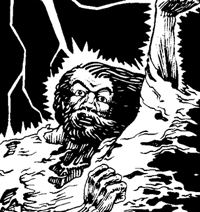Given that they're right there in the name of the game, dragons are obviously fairly key to D&D. In the 1st edition, they receive more detailed options than other monsters, having eight age categories and three size classes, and a suite of special abilities right from the beginning. Furthermore, there are no less than ten different kinds of true dragon, divided evenly between the good 'metallic' and the evil 'chromatic' species.
Thursday 1 July 2021
D&D Monsters: Black Dragons
Tuesday 22 June 2021
D&D Monsters: Wyverns
When Gygax adopted the term for D&D, he made wyverns somewhat weaker than true dragons, and unable to breathe fire. Traditional illustrations often show two-legged dragons with snake-like tails ending in a sharp point, and this became the poison stinger seen in D&D. Perhaps following on from this, there has been a tendency in fantasy fiction to make wyverns weaker than four-legged dragons, although that's perhaps turning round again more recently - in both the books and TV series, for instance, the fire-breathing and deadly dragons of Game of Thrones only have two legs.
Tuesday 8 June 2021
D&D Monsters: Carrion Crawlers and Purple Worms
 The majority of giant invertebrate monsters in the early editions of D&D are, at least in general terms, arthropods - the group of jointed-limbed creatures with chitinous exoskeletons to which insects, spiders, and crabs belong, among others. Exceptions include giant octopuses and giant squid, which are at least partially based on real animals, a few aberrations that are difficult to ally with anything real, and, somewhere in between, the purple worm. As originally drawn, the carrion crawler also qualifies, although this changes in later editions.
The majority of giant invertebrate monsters in the early editions of D&D are, at least in general terms, arthropods - the group of jointed-limbed creatures with chitinous exoskeletons to which insects, spiders, and crabs belong, among others. Exceptions include giant octopuses and giant squid, which are at least partially based on real animals, a few aberrations that are difficult to ally with anything real, and, somewhere in between, the purple worm. As originally drawn, the carrion crawler also qualifies, although this changes in later editions.The worm-like body plan is a common one among real-world invertebrates, being found in a wide range of creatures that aren't all that closely related. But, on the whole, they aren't very fearsome, and the different types don't have the recognisability factor that spiders, scorpions, praying mantises, or whatever, might have. Even in D&D, the primary threat from the purple worm comes from the fact that it's just really big. The carrion crawler is a different matter, but, then it is rather less wormlike. Both creatures have 'Ronseal' style names, although, at least to my mind, 'carrion crawler' is, like 'mind flayer', one of the more evocative ones.
Thursday 20 May 2021
D&D Monsters: Rust Monsters
Albeit, like displacer beasts and piercers, one whose name is just a rather bland description of what it does.
Tuesday 11 May 2021
D&D Monsters: Remorhaz(es)
 The remorhaz is another creature original to D&D, and one of the few such that is honoured with a proper name rather than a descriptive term. It's one of the more powerful creatures in the 1st edition that are described as simply animals, rather than intelligent beings. This is largely because it's so difficult to hurt, although it also has a bite that does more damage than that of most dragons. In later editions, it's toned down, although it remains quite fearsome.
The remorhaz is another creature original to D&D, and one of the few such that is honoured with a proper name rather than a descriptive term. It's one of the more powerful creatures in the 1st edition that are described as simply animals, rather than intelligent beings. This is largely because it's so difficult to hurt, although it also has a bite that does more damage than that of most dragons. In later editions, it's toned down, although it remains quite fearsome.1E
Tuesday 27 April 2021
D&D Monsters: Cloud and Storm Giants
 Cloud and storm giants are the most powerful of the standard races of giant in the D&D rules, the two final rungs on the ladder of increasing humanoid power. There doesn't seem to be any specific inspiration for them, although giants are sometimes associated with the sky in myths and legends. They are also the most intelligent, and the most inclined to be helpful, rather than hostile.
Cloud and storm giants are the most powerful of the standard races of giant in the D&D rules, the two final rungs on the ladder of increasing humanoid power. There doesn't seem to be any specific inspiration for them, although giants are sometimes associated with the sky in myths and legends. They are also the most intelligent, and the most inclined to be helpful, rather than hostile.1E
Tuesday 20 April 2021
D&D Monsters: Ettins
In any event, "ettin" is simply another, and older, word for "giant". In D&D, however, it specifically refers to a kind of two-headed giant; this is original to the game, but has been adopted by some other writers and computer game designers since.



